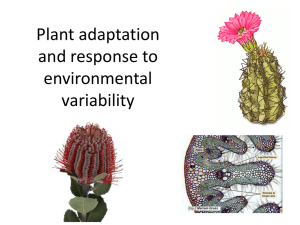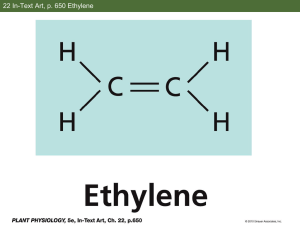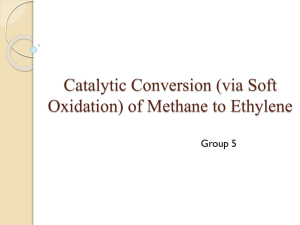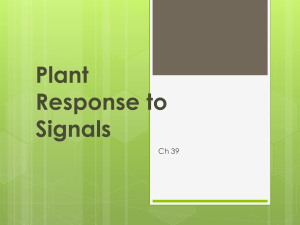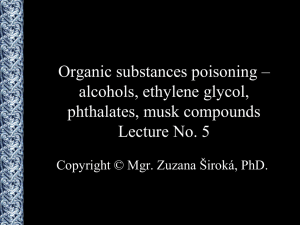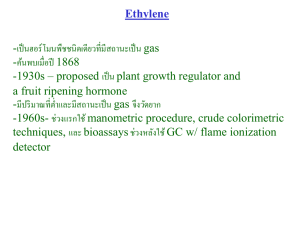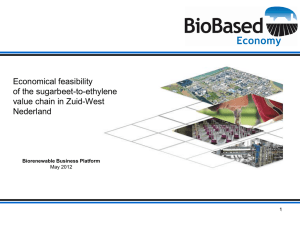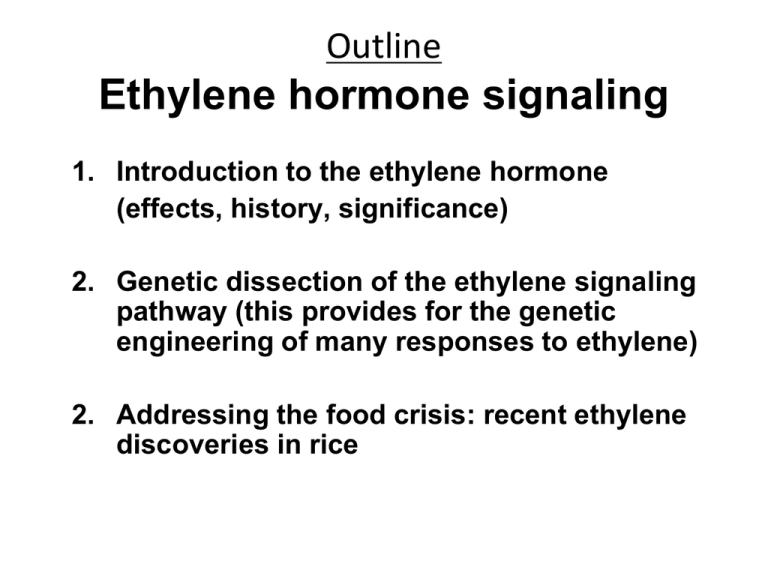
Outline
Ethylene hormone signaling
1. Introduction to the ethylene hormone
(effects, history, significance)
2. Genetic dissection of the ethylene signaling
pathway (this provides for the genetic
engineering of many responses to ethylene)
2. Addressing the food crisis: recent ethylene
discoveries in rice
Plant growth, development, and survival depend on
appropriate responses to a diverse array of constantly
fluctuating external and internal signals
ETHYLENE is a
gaseous plant
hormone.
Ethylene Biosynthesis
Wounding
Heat stress
Drought stress
Cold stress
Oxidative stress
Osmotic stress
Mechanical stress
UV stress
Pathogen attack
Biotic stress
Flooding
Ethylene responses
Developmental processes
Responses to abiotic and biotic stress
Fruit ripening - ethylene is essential
Promotion of seed germination
Root initiation
Bud dormancy release
Inhibition/promotion of flowering
Sex shifts in flowers
Senescence of leaves, flowers
Abscission of leaves, flowers, fruits
Epinasty of leaves
Inhibition/promotion of cell division/elongation
Altered geotropism in roots, stems
Induction of phytoalexins/disease resistance
Aerenchyma formation
Historical background
• Ethylene has been used (unwittingly)
throughout history
Gashing promotes ripening
in figs (4 days later)
Wood burning fires
promote synchronous
flowering in pineapple
Historical background
• Illuminating gas caused detrimental effects
Historical background
• 1901 Neljubov - ethylene is the biologically active
agent in illuminating gas
• 1934 Gane - ethylene is produced by plants
Apple slices inducing ripening of persimmons
8 days in
bag with
apple
slices
Controls,
8 days
outside
of bag
Wounding induces
ethylene production
Ethylene causes senescence
Can block ethylene receptors with silver thiosulfate
Ethylene has far-reaching consequences for agriculture and
horticulture
Transport and storage of
fruits and vegetables
requires ethylene control
“One bad apple spoils
the whole bunch…”
Flood-tolerant rice created by
expression of ethylene response
factor genes
Removal of external ethylene
Outline
Ethylene hormone signaling
1. Introduction to the ethylene hormone
(effects, history, significance)
2. Genetic dissection of the ethylene signaling
pathway (this provides for the genetic
engineering of many responses to ethylene)
2. Addressing the food crisis: recent ethylene
discoveries in rice
“Genetic Dissection” of the
Ethylene Signaling Pathway
(Question: What does this mean?)
Signal transduction
Signal
?
Response
plant cell
Signal transduction the process by which a cell
converts one kind of signal or
stimulus into another. Signal
transduction processes
typically involve an ordered
sequence of biochemical
reactions or other responses
within the cell, resulting in a
signal transduction pathway
Example of signaling pathway activated by an extracellular signal
QUESTIONS
WHAT CONSTITUTES
AN UNDERSTANDING
OF SIGNALING
PATHWAYS?
HOW CAN
RESEARCHERS
ELUCIDATE
SIGNALING
PATHWAYS?
Frequency of Signal Transduction
Publications in the Past 30 Years
The total number of papers published per year since 1977 containing the
term “signal transduction” in their title or abstract. These figures are from
analysis of papers in the MEDLINE database. The total published since Jan
1, 1977-Dec 31, 2007 is 48,377, of which 11,211 are reviews.
Cu2+
N-
Golgi
RAN1
H
H
C=C =
H
H
RTE1
-
N
ER
Cu2+
Cu2+
Cu2+
-
-C
ER/
Golgi
N
-
N
C KD
ETR1
-
CTR1
C
Degradation by
26S proteasome
Cytoplasm
ETP1/2
?
N-
EIN2
-C
EIN5/XRN4
EBF1/2
EIN3/EIL1
Degradation by the
26S proteasome via
SCFEBF1/2
EBS
ERF1
GCC
Kendrick and Chang (2008) Curr. Opin. Plant Biol. 11: 479-485
C2H4 Responsive Gene
How to genetically dissect a pathway/process
1. Identify a phenotype that is specific to the process you are
interested in
2. Design appropriate screen for isolating mutants based on this
phenotype
3. Carry out genetic analysis of the mutant (e.g., epistasis)
4. Clone the corresponding gene by map-based cloning
5. Investigate function at cell biological and biochemical levels
Arabidopsis thaliana
•
The life cycle is short--about 6 weeks
from germination to seed maturation.
•
Seed production is prolific and the
plant is easily cultivated in restricted space.
•
Self-fertilizing, but can also be out-crossed
by hand.
•
Relatively small genome (1.5 MB), completely sequenced
•
Extensive genetic and physical maps of all 5 chromosomes
•
A large number of mutant lines and genomic resources is
available - Mutants are available in nearly every gene
•
Genetic transformation is simple using Agrobacterium
tumefaciens
•
Extensive databases for gene expression analyses,
multinational projects, etc.
The seedling “triple response”
Arabidopsis thaliana
Pea seedlings
Neljubow (1901) Beih Bot Zentralbl 10,
128-139
“Triple
Response”
Seeds are
mutagenized in the
lab and then
screened for mutants
in the ethylene
signaling pathway,
based on the “triple
response” phenotype.
The mutants that we
discover correspond
to mutated genes.
Bleecker et al. (1988) Science
241, 1086–1089
Ethylene-Response Mutants in Arabidopsis
Ethylene-insensitive mutants
etr1 etr2 ein4 (dominant)
ein2 ein3 ein5 (recessive)
The WT versions of
ein6 ein7
these genes are
“Positive Regulators”
of ethylene response
C2H4
Constitutive-response mutants
ctr1 (recessive)
air
(eto1)
CTR1 is a “Negative
Regulator” of response
Molecular markers provide
a link between genetic loci
and physical DNA
Chang et al. (1988) PNAS 85: 6856-6860
*A genetic map
of molecular
markers on the
chromosome
allows one to
clone any gene
for which there is
a mutant
phenotype
Generating a mapping population
mut
mut
X
Landsberg
Columbia
hand-pollinate
heterozygous for mut
F1
self-pollinate
Recombinant genotypes
F2
1
2
3
4
Mapping population
5
.....
Example of mapping with molecular markers
Mapping population
Marker A
Marker B
Cu2+
RECEPTOR SUBFAMILIES
1
2
N-
Golgi
RAN1
H
H
C=C =
H
H
C2H4-binding
RTE1/GR
-
N
ER
Cu2+
Cu2+
Cu2+
H
Histidine
kinase
-
-C
ER/
Golgi
GAF
N
-
N
C KD
-
Degradation by the 26S
proteasome
Receiver
ETR1
CTR1
C
Cytoplasm
ETP1/2
?
EIN2
N-
-C
EIN5/XRN4
EBF1/2
EIN3/EIL1
Degradation by the
26S proteasome via
SCFEBF1/2
EBS
ERF1
GCC
C2H4 Responsive Gene
H
Arabidopsis
The tall etiolated
seedling has a
mutation in the
ethylene receptor
ETR1. The seedling
cannot detect
ethylene.
Bleecker et al. (1988) Science
241, 1086–1089
The mutant
Arabidopsis etr1-1
gene has been
transformed into
other plants where
it confers a high
level degree of
ethylene
insensitivity
Wilkinson et al. (1997)
Nature Biotech. 15: 444-448
Outline
Ethylene hormone signaling
1. Introduction to the ethylene hormone
(effects, history, significance)
2. Genetic dissection of the ethylene signaling
pathway (this provides for the genetic
engineering of many responses to ethylene)
2. Addressing the food crisis: recent ethylene
discoveries in rice
Ethylene, rice, and feeding millions
• Half the world's population eats rice as a
staple. In Asia, about 3 billion people depend
on rice to survive. The demand for food is
increasing as the population increases.
Rice is two-thirds of the diet
of subsistence farmers in
India and Bangladesh. When
rice crops suffer, millions
starve (e.g., the great floods
of 1974).
The problem
• A quarter of the world's rice grows in
areas prone to flooding.
• Rice plants normally grow well in
standing water. However, most will die if
they are completely underwater for more
than 4 days, due to lack of oxygen, carbon
dioxide and sunlight.
• Annual flooding costs rice farmers in
South and South-East Asia more than $1
billion dollars (U.S. equivalent) each year.
Flood-tolerant rice exists in
nature
• There are deepwater rice
cultivars that have evolved and
adapted to constant flooding by
acquiring the ability to elongate
their internodes, which have
hollow structures and function
as “snorkels” to allow gas
exchange with the atmosphere,
and thus prevent drowning.
internode
• HOWEVER, these deepwater varieties have
low grain yield, unlike the high-yield varieties
used for food.
Deepwater conditions. Plants were submerged in water up to 70%
of the plant height, and the water level was then increased by 10 cm
every day until the tank was full.
Tank is filled to top
Complete submergence. The tank was completely filled
with water on the first day of the treatment.
This elongated
deepwater rice
plant in Thailand
was preserved
after flooding
occurred and
shows the typical
flooding height.
White bar = 1
meter.
http://www.nature.com/nature/jo
urnal/v460/n7258/suppinfo/natur
e08258.html
Mapping the SNORKEL gene loci to the rice
chromosomes
Water
level
- Taichung65 (T65) is a non-deepwater rice
- C9285 is a deepwater rice
- NIL-12 is the progeny of a cross that transferred the key
portion of chromosome 12 into T65
Localization of SNORKEL proteins to the plant nucleus
using protein fusions to GFP
Yoko Hattori et al. (2009) Nature 460, 1026-1030
The researchers found that the SNORKEL genes belong
to the ERF (Ethylene Response Factor) family of
transcription factors, which are induced by ethylene.
Deepwater rice
Floodin
g
SNORKEL1 & 2
Transcriptional
response
Non-deepwater rice
Floodin Non-deepwater
g
rice does not
have these
genes!
No transcriptional
response
Long-term flooding vs. flash flooding
• A few rice cultivars have adapted to areas where
flash flooding is common by learning how to “hold
their breath”. These cultivars can survive under
water for up to 2 weeks.
• These cultivars do NOT use elongation as an
escape strategy. They become quiescent and stay
submerged, avoiding the energy consumption that is
involved in elongation. For example, they increase
anaerobic respiration.
• The gene controlling this response, named SUB1,
was identified and cloned in 2006. Like the
SNORKEL genes, it is also a member of the ERF
gene family.
Solving the problem
• When plants are under water, ethylene accumulates in
the plant. The ethylene then induces expression of these
ERF genes. SNORKEL1 and SNORKEL2 trigger
remarkable internode elongation via the hormone
gibberellin. In contrast, SUB1A inhibits internode
elongation.
• Now transferring these genes to high-yield cultivars.
• These engineered strains will be able to resist floods
that destroy vast tracts of rice fields each year,
preventing starvation and offering hope to hundreds of
millions of people who make their living from rice
farming.
Flood tolerant
rice:
Signaling from
ethylene to
another hormone
GA, which
controls
elongation
Responses to
Gibberellic Acid (GA)
•
•
•
•
•
•
•
•
Cell enlargement and cell
divisions in sub-apical
meristems
Growth in stems, fruits, and
leaves
Stem and leaf expansion
Fruit development and
expansion
Stimulation of flowering
Cell divisions in some tissues
Dormancy and senescence
Seed germination
Some uses of the GA hormone
•
•
During germination, the storage
starches are converted to
simple sugars for use in
seedling development. The
“malting” of barley seeds in beer
production is the process of
using GA to induce enzymes in
seed germination causing
conversion of starches to
sugars. Germination is then
stopped by heating and the
sugars are fermented.
GA induces seedlessness in
grapes, while increasing fruit
size.
Gibberellin induces growth in
Thompson’s seedless grapes
Examples of signaling pathways that researchers
are studying in plants using mutants
Developmental regulatory pathways
development of embryo, flower, leaf, root, trichome
root apical meristem formation
shoot apical meristem formation
polarity and cytoskeletal rearrangement
Specific cell fate determination and differentiation
(xylem and phloem specification, root patterning)
Abiotic stress response pathways
(salt, drought, heat, cold, metals, vernalization etc.)
Plant hormone signal transduction
(auxin, ethylene, cytokinin, gibberellin, abscisic acid,
brassinosteroid, jasmonic acid)
Which one is the wild type?
Lab Experiment: Ethylene mutant hunt
“Triple
Response”

